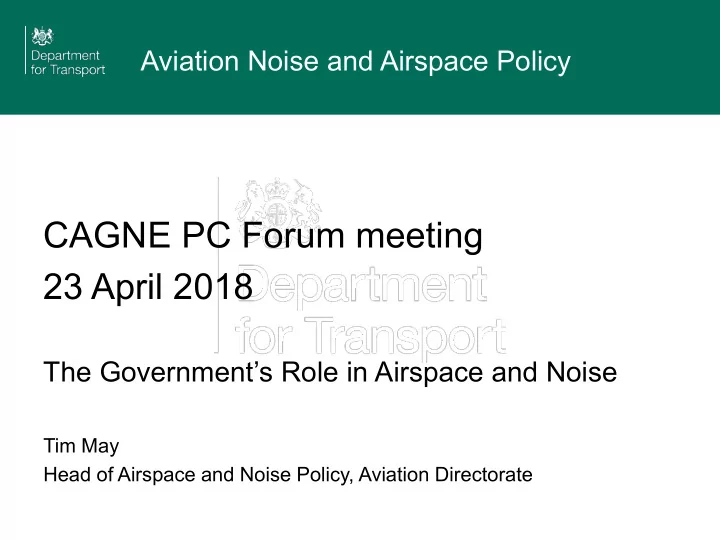

Aviation Noise and Airspace Policy CAGNE PC Forum meeting 23 April 2018 The Government’s Role in Airspace and Noise Tim May Head of Airspace and Noise Policy, Aviation Directorate
Overarching National Policy • Government sets overall policy on aviation noise which is “ to limit and, where possible reduce the number of people in the UK significantly affected by aircraft noise, as part of a policy of sharing benefits of noise reduction with industry in support of sustainable development .” • This is consistent with the Government’s Noise Policy, as set out in the Noise Policy Statement for England (2010) which “aims to avoid significant adverse impacts on health and the quality of life.”
Regulatory Overview International ICAO Balanced Approach : • Reducing noise at source (contributes >80% of noise reduction) • Land use planning • Operational procedures • Operating restrictions Sets aircraft certification and standards Legal requirements on procedures European around operating restrictions and obligations on airports to map noise exposure and produce action plans to manage noise. Gov’t sets noise Local planning controls at Heathrow, powers used to National Gatwick and Stansted restrict noise Airports required to have consultative facilities. Airports can set differential landing fees, set noise restrictions and fine airlines. SofS can direct them to use these powers. CAA can be required to consider environment when licensing aerodromes.
Government regulation • The Government has powers to set noise controls at specific airports. For many years Heathrow, Gatwick and Stansted Airports have been ‘designated’ for this purpose. • Elsewhere the Government considers noise controls should be agreed locally. This is often done through planning conditions on new airport development. • Government requires all major airports to have facilities for consultation with users and local communities (Consultative Committees).
Night restrictions At the designated airports the Government sets night flying restrictions. Current regime is 2017-22. • Stipulates number of movements and quota points (based on noise of aircraft) allowed between the hours 23.30-06.00. • Different limits for summer and winter seasons. • Movement limits unchanged since 2006. • Noise quota has reduced.
Noise abatement procedures At the designated airports the Government also sets Noise Abatement procedures. These consist of : • Noise preferential routes (departure routes – 3km corridors). • Departure noise limits, minimum height and climb gradient requirements. • Overflight restrictions over urban areas. • Joining point criteria for night-time arrivals. • Continuous Descent Approach criteria. Airports report performance against these. Airports will be responsible for consulting on and sponsoring any changes, but Government retains approval role.
Government role in airspace changes The Civil Aviation Authority is the regulator who must approve airspace changes (unless called-in). The DfT sets the policy and gives guidance to the CAA on environmental objectives relating to the exercise of its Air Navigation Functions. Revised guidance issued in 2017 which includes some significant changes: • Minimising noise is the priority up to 7,000 ft. • Move away from policy which favours concentration to a requirement to appraise options, including multiple routes for respite. • Greater transparency on noise impacts through use of new noise metrics and assessing noise to a lower level than previously. • Reconfirms that where practicable – airspace routes below 7 000ft should avoid AONBs and National Parks. • Reconfirms need to consult with local communities and reflect local views.
Current policy development • Setting up new Independent Commission on Civil Aviation Noise (ICCAN). • Working towards a new Aviation Strategy in 2019 with consultation in autumn 2018. Among other issues, this will explore whether we have the right regulation, controls and incentives for the aviation industry to continue to address its environmental impacts. • National Policy Statement (NPS) for new runway in the south east (Heathrow). Parliamentary vote expected before the summer. • Airspace modernisation – how to ensure a complex programme of changes across the South East in the 2020s is delivered. Needed for Heathrow expansion but important in its own right.
Recommend
More recommend